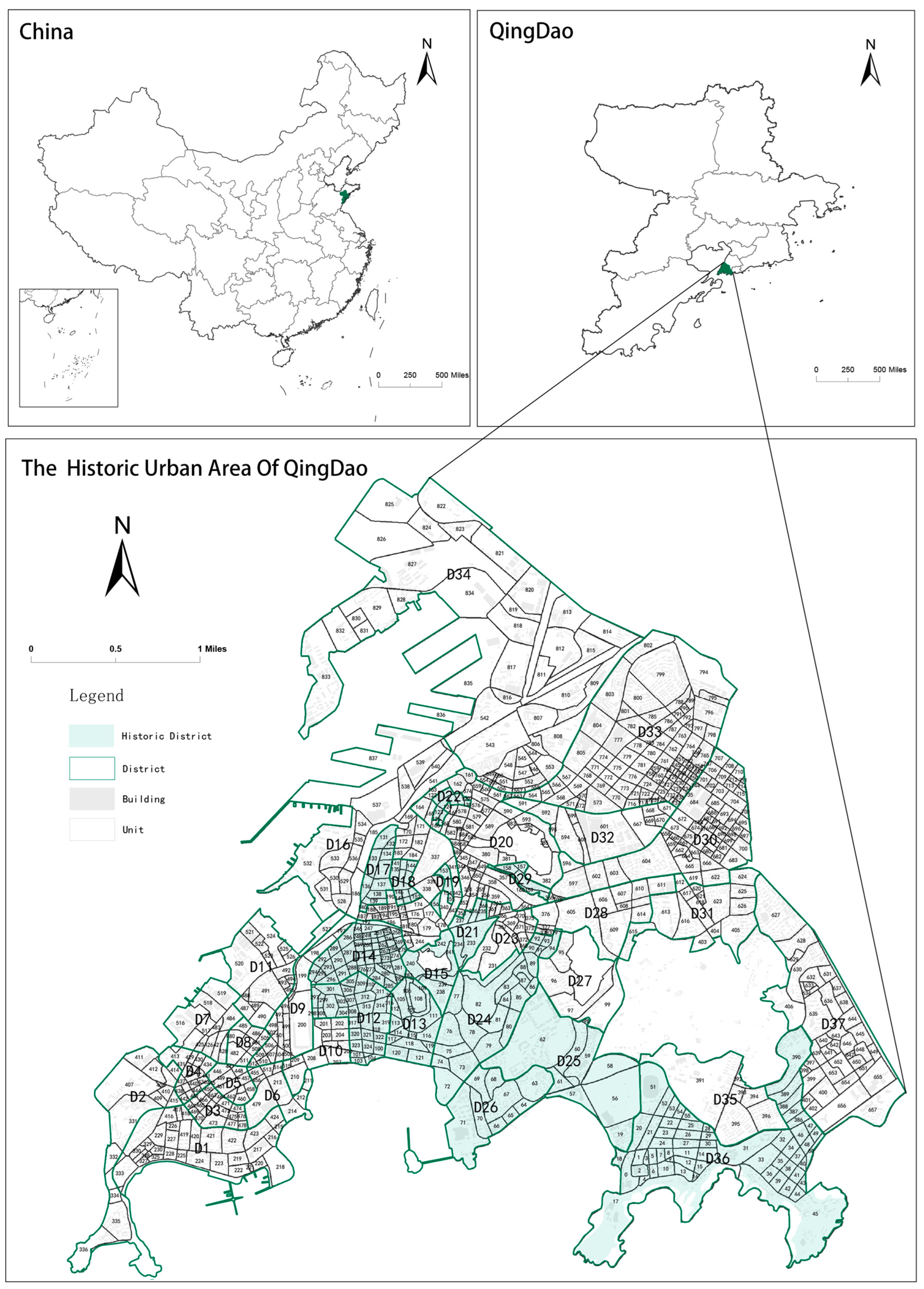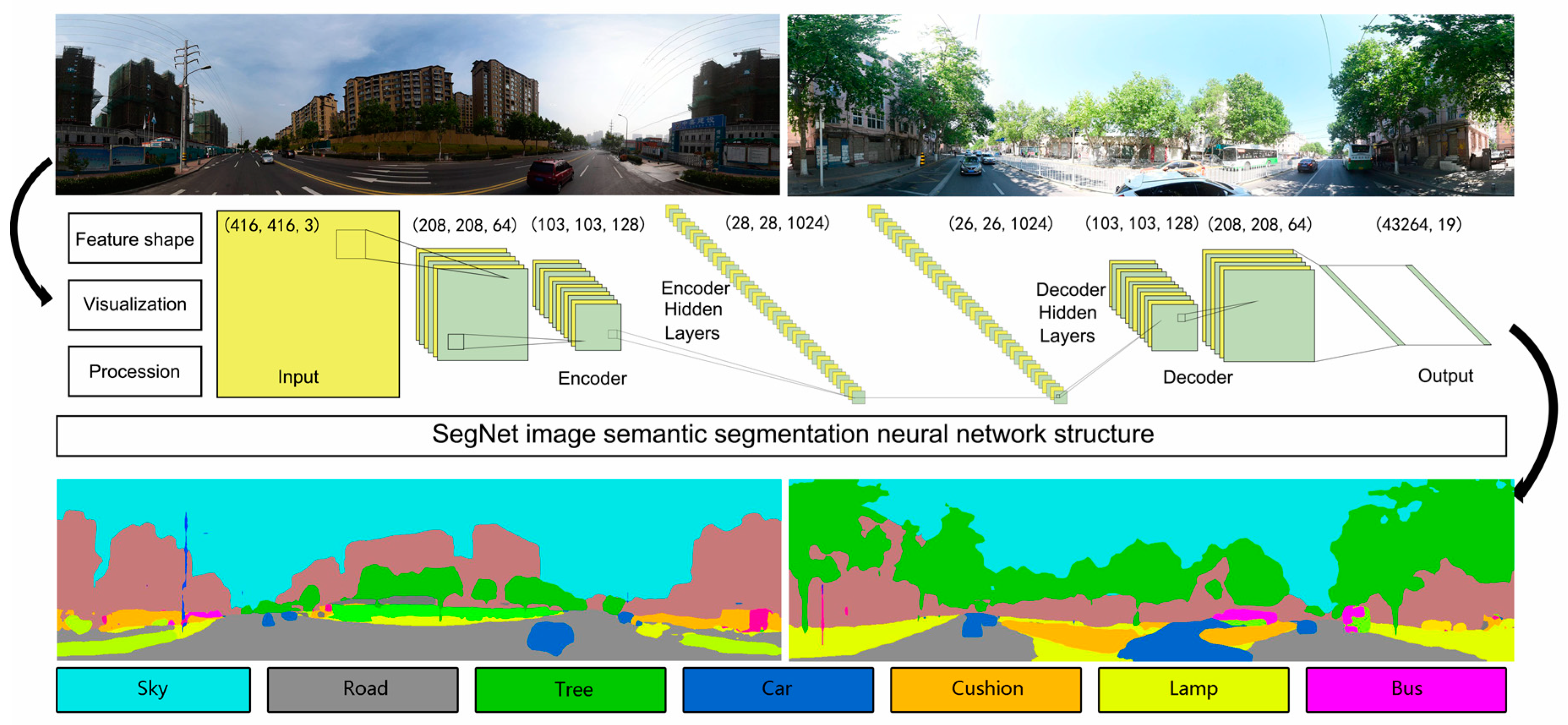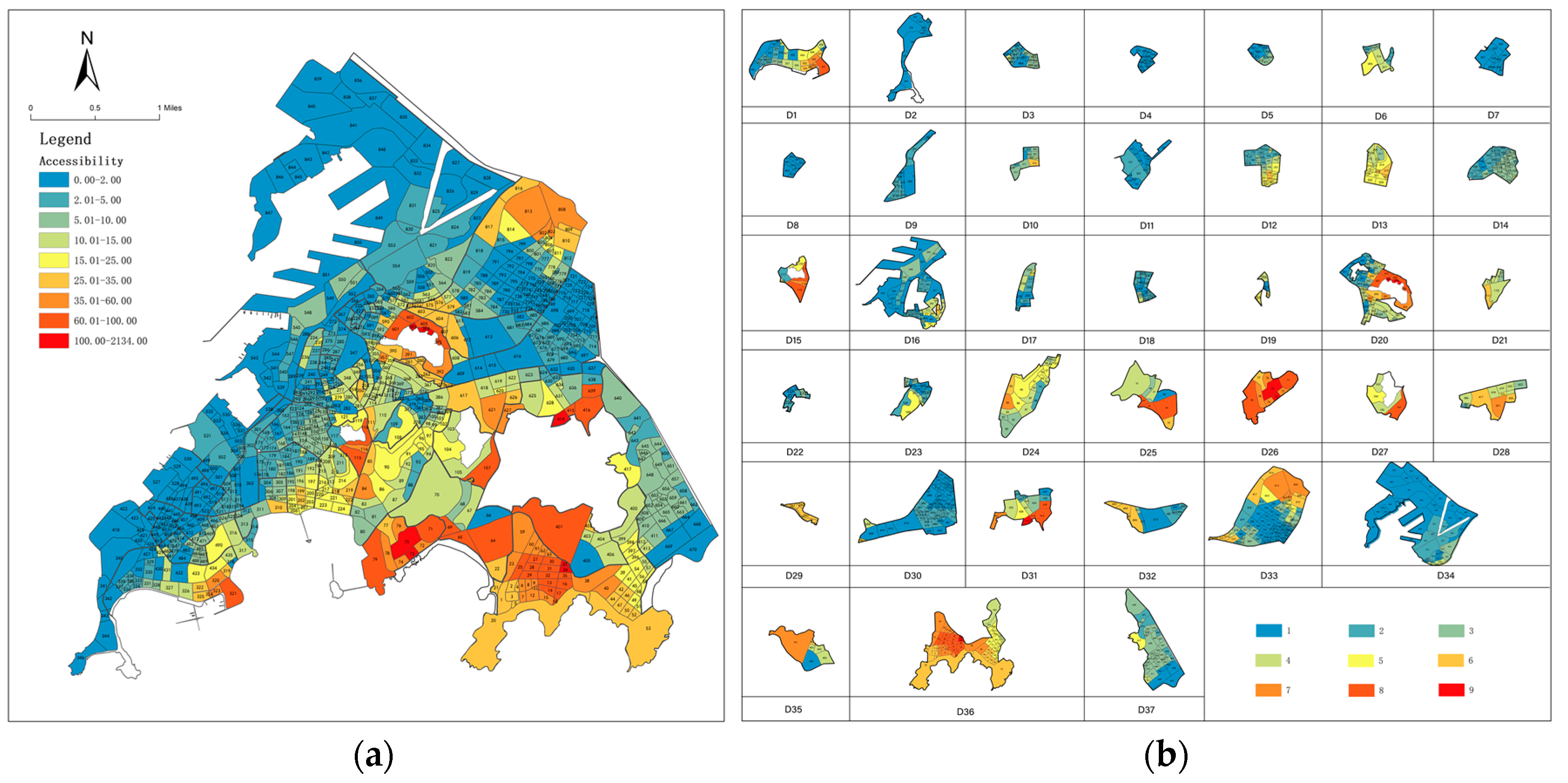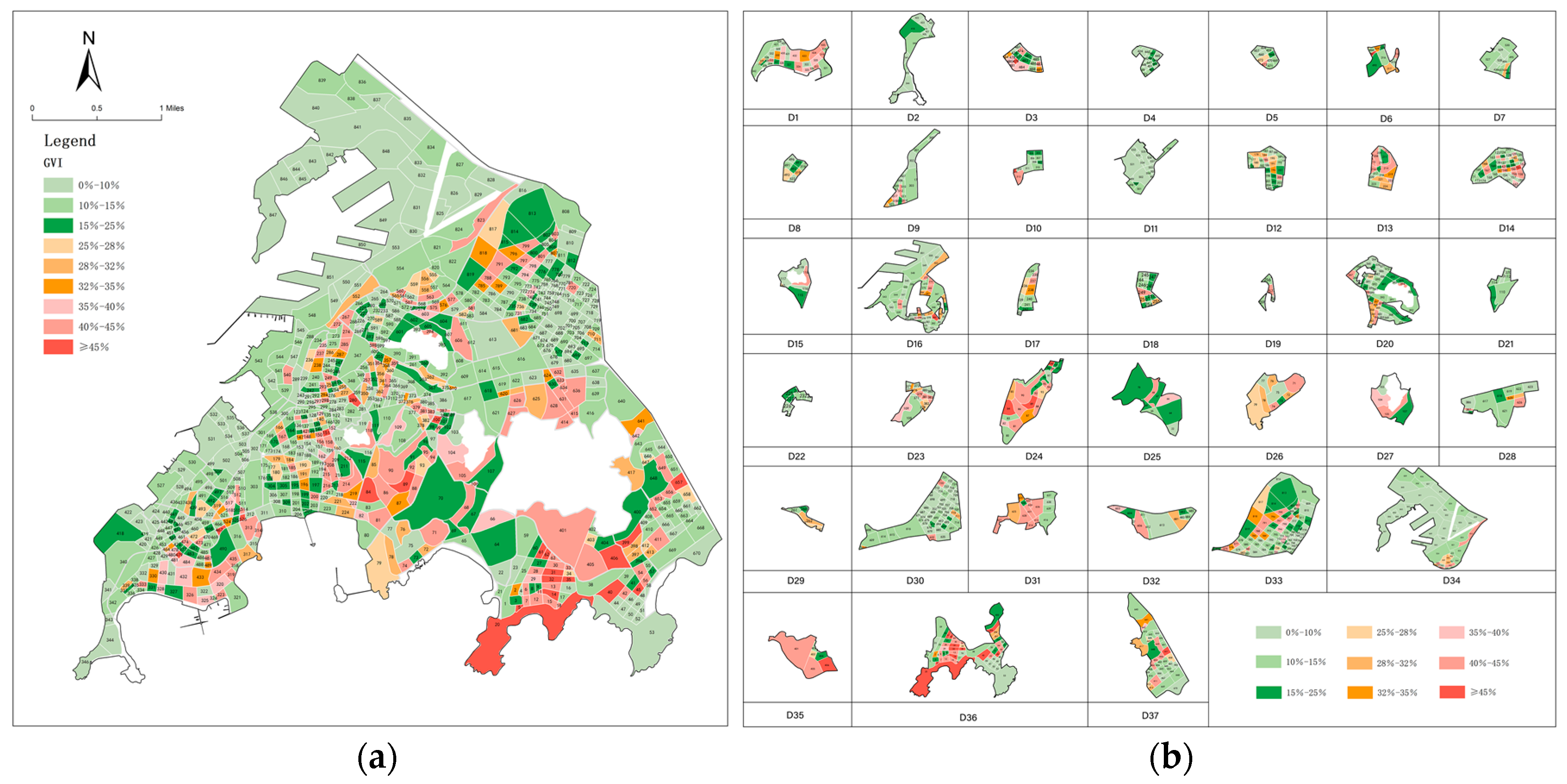Assessing Distributional and Perceived Equity of Urban Green Spaces in Qingdao’s Historic Urban Area
Abstract
:1. Introduction
2. Materials and Methods
2.1. Study Area and Data
2.2. Evaluating Distributional Equity of UGS
2.2.1. Accessibility of UGS: G2SFCA Method
2.2.2. Equity of UGS: Lorenz Curve and Gini Index
2.3. Evaluating Perceived Equity of UGS
2.3.1. Visual Perception of UGS: Green View Index
2.3.2. Equity of GVI: Location Quotient
3. Results
3.1. Distributional Equity of UGS
3.2. Perceived Equity of UGS
3.3. Classification of UGS Spatial Patterns
4. Discussion
4.1. Methodological Contributions
4.2. Implications for Urban Green Space Planning
4.3. Limitations and Future Research
5. Conclusions
Author Contributions
Funding
Data Availability Statement
Conflicts of Interest
Appendix A
| Name of District | Zone | List/Number of Units | Area of District | Range of Values | ||
|---|---|---|---|---|---|---|
| UGS Accessibility | GVI | Green Equity | ||||
| Badaxia District | D1 | 318–339, 432, 427–435 | 0.82 km2 | 0.24–70.87 | 2.4–40.2% | 0.04–0.39 |
| Tuandao District | D2 | 340–341, 343–344, 346, 419–423, 425–426 | 0.73 km2 | 0.10–1.18 | 2.1–16.3% | 0.01–0.20 |
| TaiXi District | D3 | 461–464, 474–489 | 0.16 km2 | 1.07–11.30 | 3.9–57.7% | 0.03–0.25 |
| XiZang District | D4 | 424, 440–456 | 0.16 km2 | 0.02–1.08 | 2.7–24.1% | 0.01–0.14 |
| Nuozhuang District | D5 | 475–460, 468–473 | 0.13 km2 | 0.14–5.81 | 3.5–43.1% | 0.01–0.25 |
| Xizhen District | D6 | 314–316, 466–467, 490, 524–525 | 0.24 km2 | 4.51–19.81 | 1.2–55.5% | 0.02–0.37 |
| Sichuan District | D7 | 436–439, 494–495, 527–530 | 0.35 km2 | 0.32–1.55 | 1.5–28.0% | 0.01–0.20 |
| Yunnan District | D8 | 491–493, 496–497, 516, 519, 522 | 0.13 km2 | 0.41–1.03 | 4.0–28.6% | 0.01–0.02 |
| Shouzhang District | D9 | 300–303, 507–518, 520–521, 523 | 0.04 km2 | 1.59–5.33 | 5.2–42.3% | 0.00–0.22 |
| Taiping District | D10 | 304–313, 526 | 0.23 km2 | 1.44–30.41 | 3.7–58.2% | 0.02–0.27 |
| Guangzhou District | D11 | 498, 499, 500–506, 531–538 | 0.55 km2 | 1.99–2.22 | 0.4–15.6% | 0.00–0.18 |
| Zhongshan Historic District | D12 | 175–207 | 0.41 km2 | 3.47–29.12 | 7.5–40.2% | 0.04–0.41 |
| Guanhaishan Historic District | D13 | 208–224 | 0.34 km2 | 4.46–31.85 | 4.1–41.5% | 0.07–0.42 |
| Sifang Historic District | D14 | 123–171, 173–174 | 0.42 km2 | 0.55–10.10 | 3.6–57.3% | 0.04–0.40 |
| Guanxiangshan Historic District | D15 | 115–119, 160 | 0.23 km2 | 4.95–55.64 | 0.5–40.7% | 0.01–0.35 |
| Jimo District | D16 | 120–122, 276–280, 286–299, 347–353, 539–552, 851 | 2.18 km2 | 0.50–27.50 | 2.4–55.1% | 0.00–0.26 |
| Guantao Historic District | D17 | 234–243 | 0.17 km2 | 0.41–19.32 | 2.8–40.1% | 0.00–0.28 |
| Shanghai–Wuding Historic District | D18 | 244–255 | 0.09 km2 | 0.65–10.62 | 0.5–43.7% | 0.08–0.46 |
| Xinyang Historic District | D19 | 256–259 | 0.04 km2 | 1.55–18.75 | 7.4–42.9% | 0.08–0.38 |
| Liaoning District | D20 | 264–271, 354–367, 390–395, 601–602, 605 | 1.07 km2 | 1.20–302.78 | 3.4–45.0% | 0.02–0.89 |
| Wudi Historic District | D21 | 110–114, 371 | 0.15 km2 | 9.54–33.77 | 5.2–16.3% | 0.03–0.18 |
| Changshan Historic District | D22 | 225–233 | 0.06 km2 | 1.99–5.89 | 2.1–15.1% | 0.03–0.28 |
| Jiangsu District | D23 | 108–109, 371–373, 376–384 | 0.26 km2 | 1.90–18.68 | 2.0–40.7% | 0.04–0.39 |
| Xinhaoshan Historic District | D24 | 80–102 | 0.84 km2 | 4.37–34.43 | 3.6–58.2% | 0.09–0.61 |
| Baguanshan Historic District | D25 | 22, 64–70, 106 | 0.98 km2 | 14.38–72.97 | 4.2–44.7% | 0.17–0.56 |
| Yushan Historic District | D26 | 71–79 | 0.56 km2 | 33.95–647.15 | 4.0–41.2% | 0.15–0.77 |
| Fushan District | D27 | 103–105, 107 | 0.52 km2 | 13.26–32.51 | 5.4–42.3% | 0.02–0.37 |
| Qingdao Zoo District | D28 | 386–389, 617–623, 626 | 0.52 km2 | 4.44–28.77 | 8.5–43.3% | 0.04–0.30 |
| Huangtai Historic District | D29 | 260–262 | 0.07 km2 | 30.92–32.45 | 15.7–28.4% | 0.29–0.44 |
| Yanan District | D30 | 608–610 614–616, 632, 635, 671–721 | 1.10 km2 | 0.50–27.64 | 2.1–44.1% | 0.02–0.16 |
| Qingdao TV Tower District | D31 | 414–416, 624–625, 627–628, 630–631, 633–634, 636–639 | 0.61 km2 | 1.83–2134 | 4.27–43.0% | 0.09–0.79 |
| Dengzhou District | D32 | 603–604, 606–607, 611–613, 681–685 | 0.63 km2 | 0.95–28.14 | 3.0–44.2% | 0.02–0.40 |
| Taidong District | D33 | 573–584, 730–819 | 2.02 km2 | 0.54–48.33 | 2.8–47.2% | 0.01–0.38 |
| Dagang District | D34 | 554–569, 821–847 | 4.47 km2 | 0.002–15.12 | 2.5–47.2% | 0.02–0.35 |
| Xianggangxi District | D35 | 401–406 | 0.65 km2 | 1.42–43.77 | 13.4–50.3% | 0.08–0.55 |
| Badaguan and Taipingjiao historic district | D36 | 1–58, 396–400 | 2.10 km2 | 14.53–483.22 | 4.7–64.4% | 0.12–0.54 |
| Zhanshan District | D37 | 417, 640–670 | 1.45 km2 | 0.653–18.95 | 2.7–57.2% | 0.01–0.36 |
References
- Graça, M.; Alves, P.; Gonçalves, J.; Nowak, D.J.; Hoehn, R.; Farinha-Marques, P.; Cunha, M. Assessing how green space types affect ecosystem services delivery in Porto, Portugal. Landsc. Urban Plan. 2018, 170, 195–208. [Google Scholar] [CrossRef]
- Yu, Z.; Yang, G.; Zuo, S.; Jørgensen, G.; Koga, M.; Vejre, H. Critical review on the cooling effect of urban blue-green space: A threshold-size perspective. Urban For. Urban Green. 2020, 49, 126630. [Google Scholar] [CrossRef]
- el-Baghdadi, O.; Desha, C. Conceptualising a biophilic services model for urban areas. Urban For. Urban Green. 2017, 27, 399–408. [Google Scholar] [CrossRef]
- Salingaros, N.A. The Biophilic Index Predicts Healing Effects of the Built Environment. J. Biourbanism 2019, 8, 13–14. [Google Scholar]
- Lee, S.; Kim, Y. A framework of biophilic urbanism for improving climate change adaptability in urban environments. Urban For. Urban Green. 2021, 61, 127104. [Google Scholar] [CrossRef]
- Mehaffy, M.W.; Kryazheva, Y.; Rudd, A.; Salingaros, N.A. A New Pattern Language for Growing Regions: Places, Networks, Processes; BIOPHILIC URBANISM; Sustasis Press: Portland, OR, USA, 2020; Volume 2.4, ISBN 978-0-9893469-8-6. [Google Scholar]
- Huang, Y.; Lin, T.; Xue, X.; Zhang, G.; Liu, Y.; Zeng, Z.; Zhang, J.; Sui, J. Spatial patterns and inequity of urban green space supply in China. Ecol. Indic. 2021, 132, 108275. [Google Scholar] [CrossRef]
- Huang, Y.; Lin, T.; Zhang, G.; Jones, L.; Xue, X.; Ye, H.; Liu, Y. Spatiotemporal patterns and inequity of urban green space accessibility and its relationship with urban spatial expansion in China during rapid urbanization period. Sci. Total Environ. 2022, 809, 151123. [Google Scholar] [CrossRef]
- Jiang, N. Vitality Creation of Cultural Tourism in Historic Conservation Area of Shandong Province; Qingdao Publishing House: Qingdao, China, 2022; ISBN 978-7-5552-8548-9. [Google Scholar]
- Statistical Bulletin on National Economic and Social Development of Qingdao. 2023. Available online: http://dpc.qingdao.gov.cn/fzgggz_45/zhc_45/gzdt_45/202304/t20230406_7106527.shtml (accessed on 31 March 2023).
- Sun, C.; Lin, T.; Zhao, Q.; Li, X.; Ye, H.; Zhang, G.; Liu, X.; Zhao, Y. Spatial pattern of urban green spaces in a long-term compact urbanization process—A case study in China. Ecol. Indic. 2019, 96, 111–119. [Google Scholar] [CrossRef]
- Koprowska, K.; Łaszkiewicz, E.; Kronenberg, J. Is urban sprawl linked to green space availability? Ecol. Indic. 2020, 108, 105723. [Google Scholar] [CrossRef]
- Chen, Y.; Men, H.; Ke, X. Optimizing urban green space patterns to improve spatial equity using location-allocation model: A case study in Wuhan. Urban For. Urban Green. 2023, 84, 127922. [Google Scholar] [CrossRef]
- Alexander, C.; Ishikawa, S.; Silverstein, M.; Jacobson, M.; Fiksdahl-King, I.; Angel, S. A Pattern Language: Towns, Buildings, Construction; Oxford University Press: New York, NY, USA, 1977; ISBN 13-978-0-19-501919-3. [Google Scholar]
- Nielsen, T.S.; Hansen, K.B. Do green areas affect health? Results from a Danish survey on the use of green areas and health indicators. Health Place 2007, 13, 839–850. [Google Scholar] [CrossRef] [PubMed]
- Bashneen, S.S.; Faeza, H.S.; Farjana, R. Rethinking spatial performance to address liveability of accessible neighbourhood greens (angs) in mohammadpur, dhaka. AUST J. Sci. Eng. 2017, 06, 100–115. [Google Scholar]
- Comprehensive Guide to Residential Community Development. 2021. Available online: https://www.gov.cn/zhengce/zhengceku/2022-01/12/content_5667815.htm (accessed on 17 December 2021).
- Lucas, K.; van Wee, B.; Maat, K. A method to evaluate equitable accessibility: Combining ethical theories and accessibility-based approaches. Transportation 2016, 43, 473–490. [Google Scholar] [CrossRef]
- Xiao, Y.; Wang, Z.; Li, Z.; Tang, Z. An assessment of urban park access in Shanghai–Implications for the social equity in urban China. Landsc. Urban Plan. 2017, 157, 383–393. [Google Scholar] [CrossRef]
- Nesbitt, L.; Meitner, M.J.; Sheppard, S.R.J.; Girling, C. The dimensions of urban green equity: A framework for analysis. Urban For. Urban Green. 2018, 34, 240–248. [Google Scholar] [CrossRef]
- Fasihi, H.; Parizadi, T. Analysis of spatial equity and access to urban parks in Ilam, Iran. J. Environ. Manag. 2020, 260, 110122. [Google Scholar] [CrossRef]
- Nicholls, S. Measuring the accessibility and equity of public parks: A case study using GIS. Manag. Leis. 2001, 6, 201–219. [Google Scholar] [CrossRef]
- Hillsdon, M.; Panter, J.; Foster, C.; Jones, A. The relationship between access and quality of urban green space with population physical activity. Public Health 2006, 120, 1127–1132. [Google Scholar] [CrossRef]
- Akpinar, A. How is quality of urban green spaces associated with physical activity and health? Urban For. Urban Green. 2016, 16, 76–83. [Google Scholar] [CrossRef]
- Wang, S.; Wang, M.; Liu, Y. Access to urban parks: Comparing spatial accessibility measures using three GIS-based approaches. Comput. Environ. Urban Syst. 2021, 90, 101713. [Google Scholar] [CrossRef]
- Langford, M.; Higgs, G.; Fry, R. Multi-modal two-step floating catchment area analysis of primary health care accessibility. Health Place 2016, 38, 70–81. [Google Scholar] [CrossRef] [PubMed]
- Xing, L.; Liu, Y.; Liu, X. Measuring spatial disparity in accessibility with a multi-mode method based on park green spaces classification in Wuhan, China. Appl. Geogr. 2018, 94, 251–261. [Google Scholar] [CrossRef]
- Xing, L.; Liu, Y.; Wang, B.; Wang, Y.; Liu, H. An environmental justice study on spatial access to parks for youth by using an improved 2SFCA method in Wuhan, China. Cities 2020, 96, 102405. [Google Scholar] [CrossRef]
- Hu, S.; Song, W.; Li, C.; Lu, J. A multi-mode Gaussian-based two-step floating catchment area method for measuring accessibility of urban parks. Cities 2020, 105, 102815. [Google Scholar] [CrossRef]
- Li, Z.; Fan, Z.; Song, Y.; Chai, Y. Assessing equity in park accessibility using a travel behavior-based G2SFCA method in Nanjing, China. J. Transp. Geogr. 2021, 96, 103179. [Google Scholar] [CrossRef]
- Li, X.; Huang, Y.; Ma, X. Evaluation of the accessible urban public green space at the community-scale with the consideration of temporal accessibility and quality. Ecol. Indic. 2021, 131, 108231. [Google Scholar] [CrossRef]
- Ren, X.; Guan, C. Evaluating geographic and social inequity of urban parks in Shanghai through mobile phone-derived human activities. Urban For. Urban Green. 2022, 76, 127709. [Google Scholar] [CrossRef]
- Li, Y.; Xie, Y.; Sun, S.; Hu, L. Evaluation of Park Accessibility Based on Improved Gaussian Two-Step Floating Catchment Area Method: A Case Study of Xi’an City. Buildings 2022, 12, 871. [Google Scholar] [CrossRef]
- Guo, S.; Song, C.; Pei, T.; Liu, Y.; Ma, T.; Du, Y.; Chen, J.; Fan, Z.; Tang, X.; Peng, Y.; et al. Accessibility to urban parks for elderly residents: Perspectives from mobile phone data. Landsc. Urban Plan. 2019, 191, 103642. [Google Scholar] [CrossRef]
- Konijnendijk, C.C.; Ricard, R.M.; Kenney, A.; Randrup, T.B. Defining urban forestry—A comparative perspective of North America and Europe. Urban For. Urban Green. 2006, 4, 93–103. [Google Scholar] [CrossRef]
- Feng, X.; Astell-Burt, T. Residential Green Space Quantity and Quality and Child Well-being: A Longitudinal Study. Am. J. Prev. Med. 2017, 53, 616–624. [Google Scholar] [CrossRef] [PubMed]
- De Vries, S.; van Dillen, S.M.E.; Groenewegen, P.P.; Spreeuwenberg, P. Streetscape greenery and health: Stress, social cohesion and physical activity as mediators. Soc. Sci. Med. 2013, 94, 26–33. [Google Scholar] [CrossRef] [PubMed]
- Ma, B.; Hauer, R.J.; Ostberg, J.; Koeser, A.K.; Wei, H.; Xu, C. A global basis of urban tree inventories: What comes first the inventory or the program. Urban For. Urban Green. 2021, 60, 127087. [Google Scholar] [CrossRef]
- Neyns, R.; Canters, F. Mapping of Urban Vegetation with High-Resolution Remote Sensing: A Review. Remote Sens. 2022, 14, 1031. [Google Scholar] [CrossRef]
- Ye, Y.; Richards, D.; Lu, Y.; Song, X.; Zhuang, Y.; Zeng, W.; Zhong, T. Measuring daily accessed street greenery: A human-scale approach for informing better urban planning practices. Landsc. Urban Plan. 2019, 191, 103434. [Google Scholar] [CrossRef]
- Lu, Y.; Yang, Y.; Sun, G.; Gou, Z. Associations between overhead-view and eye-level urban greenness and cycling behaviors. Cities 2019, 88, 10–18. [Google Scholar] [CrossRef]
- Wang, R.; Helbich, M.; Yao, Y.; Zhang, J.; Liu, P.; Yuan, Y.; Liu, Y. Urban greenery and mental wellbeing in adults: Cross-sectional mediation analyses on multiple pathways across different greenery measures. Environ. Res. 2019, 176, 108535. [Google Scholar] [CrossRef]
- Seiferling, I.; Naik, N.; Ratti, C.; Proulx, R. Green streets—Quantifying and mapping urban trees with street-level imagery and computer vision. Landsc. Urban Plan. 2017, 165, 93–101. [Google Scholar] [CrossRef]
- Wang, J.; Liu, W.; Gou, A. Numerical characteristics and spatial distribution of panoramic Street Green View index based on SegNet semantic segmentation in Savannah. Urban For. Urban Green. 2022, 69, 127488. [Google Scholar] [CrossRef]
- Li, X.; Zhang, C.; Li, W.; Ricard, R.; Meng, Q.; Zhang, W. Assessing street-level urban greenery using Google Street View and a modified green view index. Urban For. Urban Green. 2015, 14, 675–685. [Google Scholar] [CrossRef]
- Liu, Y.; Pan, X.; Liu, Q.; Li, G. Establishing a Reliable Assessment of the Green View Index Based on Image Classification Techniques, Estimation, and a Hypothesis Testing Route. Land 2023, 12, 1030. [Google Scholar] [CrossRef]
- Lu, Y.; Ferranti, E.J.S.; Chapman, L.; Pfrang, C. Assessing urban greenery by harvesting street view data: A review. Urban For. Urban Green. 2023, 83, 127917. [Google Scholar] [CrossRef]
- Quercia, D.; O’Hare, N.K.; Cramer, H. Aesthetic capital: What makes london look beautiful, quiet, and happy? In Proceedings of the 17th ACM conference on Computer Supported Cooperative work & Social Computing; Association for Computing Machinery, New York, NY, USA, 15–19 February 2014.
- Yu, X.; Zhao, G.; Chang, C.; Yuan, X.; Heng, F. BGVI: A New Index to Estimate Street-Side Greenery Using Baidu Street View Image. Forests 2019, 10, 3. [Google Scholar] [CrossRef]
- Helbich, M.; Yao, Y.; Liu, Y.; Zhang, J.; Liu, P.; Wang, R. Using deep learning to examine street view green and blue spaces and their associations with geriatric depression in Beijing, China. Environ. Int. 2019, 126, 107–117. [Google Scholar] [CrossRef]
- Cheng, L.; Chu, S.; Zong, W.; Li, S.; Wu, J.; Li, M. Use of Tencent Street View Imagery for Visual Perception of Streets. ISPRS Int. J. Geo-Inf. 2017, 6, 265. [Google Scholar] [CrossRef]
- Dai, L.; Zheng, C.; Dong, Z.; Yao, Y.; Wang, R.; Zhang, X.; Ren, S.; Zhang, J.; Song, X.; Guan, Q. Analyzing the correlation between visual space and residents’ psychology in Wuhan, China using street-view images and deep-learning technique. City Environ. Interact. 2021, 11, 100069. [Google Scholar] [CrossRef]
- Wang, R.; Feng, Z.; Pearce, J.; Liu, Y.; Dong, G. Are greenspace quantity and quality associated with mental health through different mechanisms in Guangzhou, China: A comparison study using street view data. Environ. Pollut. 2021, 290, 117976. [Google Scholar] [CrossRef]
- Aoki, Y. Relationship between percieved greenery and width of visual fields. J. Jpn. Inst. Landsc. Archit. 1987, 51, 1–10. [Google Scholar] [CrossRef]
- Sun, D.; Ji, X.; Gao, W.; Zhou, F.; Yu, Y.; Meng, Y.; Yang, M.; Lin, J.; Lyu, M. The Relation between Green Visual Index and Visual Comfort in Qingdao Coastal Streets. Buildings 2023, 13, 457. [Google Scholar] [CrossRef]
- CJJ/T 85-2017; Urban Green Spaces Classification Standard. China Architecture Publishing: Beijing, China, 2018.
- World Urbanization Prospects: The 2018 Revision|United Nations iLibrary. Available online: https://www.un-ilibrary.org/content/books/9789210043144 (accessed on 12 September 2023).
- Knez, I.; Ode Sang, Å.; Gunnarsson, B.; Hedblom, M. Wellbeing in Urban Greenery: The Role of Naturalness and Place Identity. Front Psychol. 2018, 9, 491. [Google Scholar] [CrossRef]
- Cheesbrough, A.E.; Garvin, T.; Nykiforuk, C.I.J. Everyday wild: Urban natural areas, health, and well-being. Health Place 2019, 56, 43–52. [Google Scholar] [CrossRef] [PubMed]
- Zheng, Z.; Shen, W.; Li, Y.; Qin, Y.; Wang, L. Spatial equity of park green space using KD2SFCA and web map API: A case study of zhengzhou, China. Appl. Geogr. 2020, 123, 102310. [Google Scholar] [CrossRef]
- Larkin, A.; Hystad, P. Evaluating street view exposure measures of visible green space for health research. J Expo. Sci. Environ. Epidemiol. 2019, 29, 447–456. [Google Scholar] [CrossRef] [PubMed]
- Liang, J.; Gong, J.; Sun, J.; Zhou, J.; Li, W.; Li, Y.; Liu, J.; Shen, S. Automatic Sky View Factor Estimation from Street View Photographs—A Big Data Approach. Remote Sens. 2017, 9, 411. [Google Scholar] [CrossRef]
- Lauko, I.G.; Honts, A.; Beihoff, J.; Rupprecht, S. Local color and morphological image feature based vegetation identification and its application to human environment street view vegetation mapping, or how green is our county? Geo-Spat. Inf. Sci. 2020, 23, 222–236. [Google Scholar] [CrossRef]
- Han, Y.; Zhong, T.; Yeh, A.G.O.; Zhong, X.; Chen, M.; Lü, G. Mapping seasonal changes of street greenery using multi-temporal street-view images. Sustain. Cities Soc. 2023, 92, 104498. [Google Scholar] [CrossRef]
- Zhang, S. The Idea and Path of Establishing the Mechanism of Preserving the Urban Living Heritage: Shanghai’s Experience and Challenges in Historic Townscape Preservation. Urban Plan. Forum. 2021, 100–108. [Google Scholar] [CrossRef]








| Accessibility | Level | Range of Values | Number of Units | Area of Units |
|---|---|---|---|---|
| Low Accessibility | 1 | 0.00 ≤ A ≤ 2.00 | 310 | 12.27 km2 |
| 2 | 2.01 ≤ A ≤ 5.00 | 147 | 2.90 km2 | |
| 3 | 5.01 ≤ A ≤ 10.00 | 109 | 2.37 km2 | |
| Medium Accessibility | 4 | 10.01 ≤ A ≤ 15.00 | 92 | 2.71 km2 |
| 5 | 15.01 ≤ A ≤ 25.00 | 75 | 0.16 km2 | |
| 6 | 25.01 ≤ A ≤ 35.00 | 53 | 2.14 km2 | |
| High Accessibility | 7 | 35.01 ≤ A ≤ 60.00 | 42 | 1.90 km2 |
| 8 | 60.01 ≤ A ≤ 100.00 | 15 | 0.91 km2 | |
| 9 | 100.01 ≤ A ≤ 2134.00 | 8 | 0.17 km2 |
| GVI | Level | Range of Values | Number of Units | Area of Units |
|---|---|---|---|---|
| Low greenery | 1 | 0% 10% | 290 | 8.97 km2 |
| 2 | 10% 15% | 202 | 6.77 km2 | |
| 3 | 15% 25% | 106 | 3.11 km2 | |
| Medium greenery | 4 | 25% 28% | 22 | 0.64 km2 |
| 5 | 28% 32% | 39 | 0.96 km2 | |
| 6 | 32% 35% | 34 | 0.57 km2 | |
| High greenery | 7 | 35% 40% | 30 | 0.65 km2 |
| 8 | 40% 45% | 106 | 2.95 km2 | |
| 9 | 5% | 22 | 0.91 km2 |
| Green Equity | Level | Range of Values | Number of Units | Area of Units |
|---|---|---|---|---|
| Low | 1 | 0.00 ≤ F < 0.05 | 344 | 17.45 km2 |
| 2 | 0.05 ≤ F < 0.10 | 173 | 3.04 km2 | |
| 3 | 0.10 ≤ F < 0.20 | 126 | 2.03 km2 | |
| Medium | 4 | 0.20 ≤ F < 0.25 | 56 | 0.27 km2 |
| 5 | 0.25 ≤ F < 0.35 | 91 | 0.50 km2 | |
| 6 | 0.35 ≤ F < 0.45 | 22 | 0.18 km2 | |
| High | 7 | 0.45 ≤ F < 0.55 | 13 | 0.89 km2 |
| 8 | 0.55 ≤ F < 0.65 | 18 | 1.01 km2 | |
| 9 | 0.65 ≤ F ≤ 0.90 | 8 | 0.15 km2 |
Disclaimer/Publisher’s Note: The statements, opinions and data contained in all publications are solely those of the individual author(s) and contributor(s) and not of MDPI and/or the editor(s). MDPI and/or the editor(s) disclaim responsibility for any injury to people or property resulting from any ideas, methods, instructions or products referred to in the content. |
© 2023 by the authors. Licensee MDPI, Basel, Switzerland. This article is an open access article distributed under the terms and conditions of the Creative Commons Attribution (CC BY) license (https://creativecommons.org/licenses/by/4.0/).
Share and Cite
Jiang, N.; Li, X.; Peng, Z.; Ban, Q.; Feng, Y. Assessing Distributional and Perceived Equity of Urban Green Spaces in Qingdao’s Historic Urban Area. Buildings 2023, 13, 2822. https://doi.org/10.3390/buildings13112822
Jiang N, Li X, Peng Z, Ban Q, Feng Y. Assessing Distributional and Perceived Equity of Urban Green Spaces in Qingdao’s Historic Urban Area. Buildings. 2023; 13(11):2822. https://doi.org/10.3390/buildings13112822
Chicago/Turabian StyleJiang, Naibin, Xinyu Li, Zhen Peng, Qichao Ban, and Yuting Feng. 2023. "Assessing Distributional and Perceived Equity of Urban Green Spaces in Qingdao’s Historic Urban Area" Buildings 13, no. 11: 2822. https://doi.org/10.3390/buildings13112822






